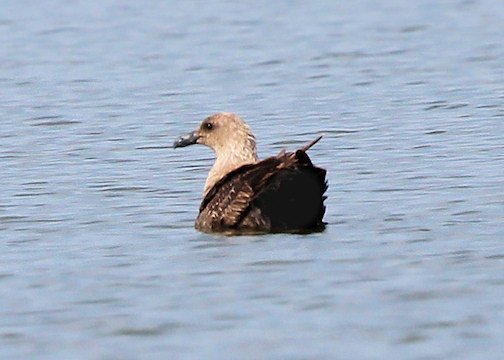by John Shackford

The South Polar Skua (Stercorarius maccormicki) that showed up at least from August 7- August 10, 2013 at Lake Overholser was more like the Oklahoma bird of the decade or century than bird of the month. Tony Solorio and his father Jim photographed the bird on August 7, thinking it was a jaeger. On August 8, Mikey Lutmerding, (apparently a northeastern U.S birder), was the first to suggest that this bird was a South Polar Skua. Clarity on the bird’s identification soon began to take shape thanks to Chad Ellis’ posting to eBird. A group of experienced ornithologists with Cornell Lab of Ornithology, including Marshall Iliff and eBird contributors, collaborated and identified the bird. Then the fun began!
I thought this would be an easy bird of the month to write about—but I was wrong. The reason it has not been easy is that hard information on skuas seems to me to be, at the current time, somewhat mushy. To quote a line from Seabird Osteology, “The five species of skuas are more or less of the same size and appearance.” To complicate the situation further the 3 species of jaegers are smaller versions of the larger skuas, and all of both the skuas and jaegers have dark forms, which are understandably easy to confuse with one another. Furthermore, skuas and jaegers tend to nest somewhere near both ends of the earth, areas where research is not easily undertaken. Perhaps you are beginning to see the problem of identification of this group of birds. It aint easy!
Many people from around this part of the nation—Kansas City, Wichita, Dallas, Arkansas—came to see the bird. Several people photographed the bird at reasonably close range, so the experts do have a considerable amount of material from which to draw their conclusions. Trusting the experts, let’s accept that this bird is that skua. (As you can tell, I am a chicken when it comes to calling tricky bird IDs, especially of those birds I have never seen. Where was I when the skua was here? I had been accidentally dropped from OKBirds and I missed the whole thing because of that.)
South Polar Skuas are about 21 inches long, with wingspans of about 52 inches, so they have a wider wingspan than the widest jaegar, the Pomarine, at 48 inches. This skua harasses other birds to make them drop or throw up food, or predates other birds directly as meals. The bird at Lake Overholser, from the photos I have seen, knocked down at least 2 Cattle Egrets and 1 Yellow-crowned Night-Heron. From the photographs it was evident that these birds were completely at the mercy of the skua. Other birds seen to be pursued and caught also were a probable Little Blue Heron and some species of tern. The skua appeared to be getting plenty of opportunities for food by knocking other birds out of the sky.
The nesting range of the South Polar Skua is only in Antarctica and it nests on the ground, since there are no trees in Antarctica. They lay 1-3 eggs but usually 2. When the bird is not nesting it is an oceanic bird almost exclusively. During the Antarctic winter, which is our summer, this skua migrates northward to warmer climes and is infrequently seen as far north in latitude as Oklahoma in the Pacific and Atlantic oceans. What a treat for so many people to have the unusual opportunity to see one of these truly oceanic birds inland–in Oklahoma, no less.
